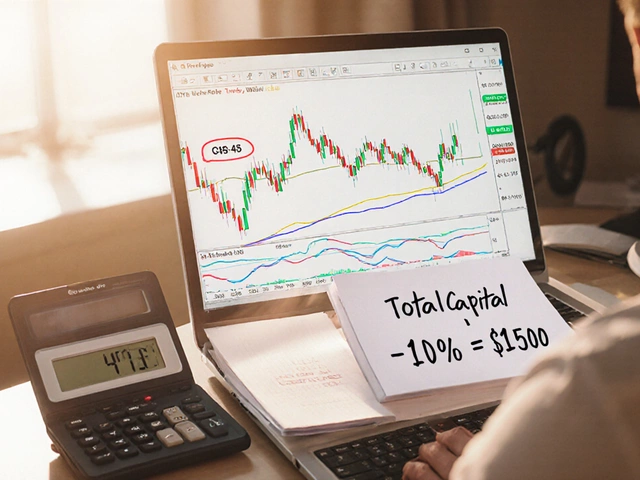
If you have $10,000 just hanging out in a regular savings account, you’re probably not earning much interest—think pennies. But toss that same money into a high-yield savings account, and you’ll start to see some actual growth, even while you sleep. These accounts have one job: help your money earn more just for sitting there, risk-free.
Banks know people want better returns, so they offer online savings accounts with interest rates way higher than what you’ll get at a traditional brick-and-mortar bank. Right now in April 2025, the average high-yield rate is around 4.5% to 5%. Sounds nice, but what does that mean in real dollars? Spoiler: it’s way more than your hometown bank’s 0.01%.
If you’re curious how much your $10,000 could grow in a year, or what you need to know before parking your cash, you’re in the right place. I’ll break down the math, explain what really matters with these accounts, and show you what to watch for before signing up. Use this info to squeeze the most out of every dollar you’ve worked hard to save. Ready to see what your money can really do?
- How High-Yield Savings Accounts Work
- Crunching the Numbers: What $10,000 Can Earn
- Why Interest Rates Matter
- Account Features to Look For
- Tips for Boosting Your Savings
- Common Questions Answered
How High-Yield Savings Accounts Work
So, what sets a high-yield savings account apart from the savings account your parents probably used? It’s all about the interest rate—basically, how fast your money grows just by sitting in the bank. Traditional savings accounts might offer you a measly 0.01% interest, barely even enough for a coffee pickup at the end of the year. In contrast, high-yield savings accounts today offer more like 4.5% or sometimes even north of 5% annual percentage yield (APY).
Most of these accounts live online. Since online banks don’t have to pay for fancy branches and overhead, they pass the savings onto you in the form of a higher rate. That’s why you’ll see the best interest rates from online banks or credit unions. The thing is, your money isn’t being put at risk—these accounts are still FDIC-insured up to $250,000 per depositor, per bank. So even though you’re chasing a higher rate, your cash is as safe as in any regular bank account.
Here's what you need to know about how they work:
- Interest compounds: In most cases, interest is calculated daily and paid out monthly, which means you earn 'interest on your interest.' Over time, this helps your money grow a little faster than you might expect.
- No risky business: These accounts don’t invest your money in stocks or crypto. It’s just good-old savings, with a better return.
- Easy access: While you can’t write checks directly from these accounts, you can transfer money to and from your regular checking account anytime via online banking or an app. Most don’t charge monthly maintenance fees.
Take a look at how the numbers stack up over a year:
| Savings Account | Interest Rate (APY) | Earnings After 1 Year on $10,000 |
|---|---|---|
| Big Bank (Traditional) | 0.01% | $1 |
| Online High-Yield | 4.5% | $450 |
| Top-Tier High-Yield | 5.0% | $500 |
Bottom line: With a high-yield savings account, you’re turning lazy money into hardworking money. If you’re serious about making every dollar count, there’s really no contest here.
Crunching the Numbers: What $10,000 Can Earn
So, how much does $10,000 in a high-yield savings account actually make you in a year? Let's do some quick math. If you snag an account offering a 5% annual interest rate, things look a lot better than a regular savings account. High-yield accounts usually pay interest monthly and calculate your earnings using something called compound interest. That means each month, you start earning interest not just on your original $10,000, but also on anything you earned so far. Yep, it’s interest on your interest, and it adds up faster than you think.
Here’s how your money grows at 5% APY, compounded monthly:
| Month | Balance ($) |
|---|---|
| 0 | 10,000.00 |
| 6 | 10,253.39 |
| 12 | 10,511.62 |
At the end of one year, you’d have about $10,511.62. That’s $511.62 in pure interest, just from parking your money.
If you kept it there and didn’t touch it for 5 years, your $10,000 turns into about $12,762. That’s almost $2,800 earned, thanks to compounding. Now compare that to a standard savings account paying 0.01%—you’d barely make $1 after a year!
Important stuff to keep in mind for anyone considering this move:
- Interest rates can change over time, so your actual earnings might look different next year.
- Banks show rates as APY (Annual Percentage Yield), and that number already includes the effects of compounding.
- You usually don’t need to deposit or keep a huge balance—$10,000 is plenty to see real results.
Bottom line: If your money’s just sitting there doing nothing, a high-yield savings account is a no-brainer for getting more out of every dollar.
Why Interest Rates Matter
The whole point of a high-yield savings account is the interest rate. That number decides how much money you actually earn, and even a small difference adds up faster than most people think. If your old-school bank is offering 0.01% on your savings, you’d earn a dollar a year on $10,000—maybe enough for one cup of coffee, if you’re lucky. But high-yield accounts these days are paying 4.5% or more, so your earnings jump dramatically. Simple as that.
Banks pay you interest as a way to borrow your money (that’s how they make loans to other people). When interest rates go up, banks compete harder to get your savings, so the percentage gets bigger. When rates drop, your account might not feel as exciting—but the best high-yield savings accounts are still leaps better than traditional options.
Here’s what a difference the interest rate really makes. Let’s compare $10,000 in a regular account versus a high-yield one after one year, assuming no withdrawals:
| Account Type | Interest Rate | 1-Year Earnings |
|---|---|---|
| Regular Savings | 0.01% | $1 |
| High-Yield Savings | 4.5% | $450 |
That’s a $449 difference, just from choosing a smarter home for your money! Even if you don’t have a ton to stash away, moving it to a high-yield savings account puts easy, risk-free cash back into your pocket. And if you leave that cash sitting year after year, compound interest will work in your favor, stacking your earnings over time.
When shopping for best savings accounts, the top thing on my checklist is the interest rate. Always. It’s the main lever that moves your balance up, with zero effort required from you. Don’t settle for tiny numbers when you can grab a higher rate with a simple online switch.

Account Features to Look For
Don’t just chase the highest rate and call it a day. Picking the right high-yield savings account means looking at the whole package. Some banks hook you with flashy numbers, but hide the pain in fees, limits, or annoying fine print. Here’s what you actually want to check before dropping in your $10,000.
- Interest Rate (APY): This is the headline. As of April 2025, top online banks are offering between 4.5% and 5% APY. That gap adds up, especially if you plan to leave your stash untouched all year.
- No Monthly Fees: Some banks quietly take a chunk out of your savings with monthly charges. The best bank accounts have zero maintenance fees—don’t pay to park your own money.
- Minimum Balance Requirements: Watch for banks that ask you to keep a minimum, like $5,000 just to avoid fees or get the highest rate. Plenty of good accounts have no minimum, so shop around.
- Withdrawal Limits and Access: Most savings accounts still cap you at about 6 withdrawals a month, even these days. If you need lots of transfers, check the rules. Some banks clamp down with extra fees or lock you out if you go over.
- FDIC Insurance: Only use FDIC-insured banks (or NCUA for credit unions). This way, your money—up to $250,000 per depositor per bank—is safe even if the bank suddenly tanks.
- Mobile and Online Access: Can you manage everything on your phone? Deposit checks, transfer cash, pay bills? The best high-yield savings accounts make this smooth and easy, not a headache.
To see how a few top picks stack up, check this quick comparison:
| Bank | APY | Monthly Fee | Min. Balance |
|---|---|---|---|
| Ally Bank | 4.50% | $0 | $0 |
| Marcus by Goldman Sachs | 4.75% | $0 | $0 |
| Discover Online Savings | 4.60% | $0 | $0 |
So when you’re picking where to stash your $10,000, look for a combo of great rate, no hidden costs, easy access, and full safety. Don’t forget—banks change rates a lot, so review your account every few months to make sure you’re still getting the best deal.
Tips for Boosting Your Savings
Want to get the most out of your high-yield savings account? There are a few smart moves anyone can make—no financial degree required. These tips can make a real difference in how fast your balance grows. Honestly, a couple tweaks here and there can add up to more cash for you.
- Chase the best rates, not the big names: Some big banks try to impress with shiny apps, but it’s usually the online or smaller banks that offer the best interest rates. Don’t be afraid to move your money if a different bank posts a higher APY.
- Automate your deposits: Set up an automatic transfer from your checking account every payday. Even $50 a week adds up to $2,600 in a year—and you won’t miss what you don’t see.
- Don’t withdraw unless you must: These accounts are for saving, not spending. Each withdrawal means you lose out on future interest. Plus, some banks limit the number of monthly withdrawals before tacking on fees.
- Watch out for fees: Always read the fine print. Many high-yield accounts kill your earnings with monthly or low-balance fees. Go for accounts with zero monthly charges and no minimums.
- Check if your balance could earn more: Some banks offer different rates based on balance tiers. If your $10,000 savings grows over time, check if you qualify for a higher APY or if moving a chunk to another account makes sense.
Here’s a quick look at what happens when you add $100 each month to your $10,000 savings over a year at 5% interest:
| Month | Balance |
|---|---|
| 0 | $10,000.00 |
| 6 | $10,611.57 |
| 12 | $11,253.49 |
Little boosts make a difference, even with a single, consistent deposit. Some banks let you round up your purchases—each coffee or dog treat for Rusty kicks spare change into your savings. No magic, just building better habits and putting your high-yield account to work.
Common Questions Answered
If you’re new to high-yield savings or just want to make sure you’re getting the best deal for your $10,000, you’re not alone. I get these questions from friends, family, and even neighbors at the dog park with Rusty. Here’s what people always want to know:
1. Are high-yield savings accounts safe?
Yes—if you choose an FDIC-insured bank (or NCUA for credit unions), your money is protected up to $250,000 per depositor. So even if the bank goes under, your cash is covered.
2. Can my rate change after I open an account?
Definitely. These rates aren’t locked in. Banks can adjust them based on economic conditions—sometimes up, sometimes down. That’s why it’s smart to keep an eye on emails from your bank or check their site so you notice if your rate drops.
3. How often is interest paid?
Most high-yield savings accounts pay interest monthly and compound daily. That’s a win, because daily compounding lets your money earn a smidge more over the same period. Here’s what that looks like with $10,000 at a 5% annual yield after one year:
| Account Type | Compounding | Interest Earned (1 Year) |
|---|---|---|
| Traditional Savings | Monthly | $1.50 |
| High-Yield Savings | Daily | $511.62 |
Rates vary, but you get the idea: daily compounding plus a higher rate makes a big difference.
4. Do I need to pay taxes on my interest?
Yep. The IRS treats interest from bank accounts as income. Your bank will send you a 1099-INT form if you earn $10 or more in a year. It goes on your tax return, the same way you’d list income from a side gig.
5. Are there fees I should watch out for?
- Monthly maintenance fees (rare for online accounts, but double check)
- Transfer limits or excessive withdrawal fees (federal rule change in 2020 removed the six-per-month limit, but some banks still have their own rules)
- Minimum balance requirements
Pro tip: The best accounts on top-rated bank accounts lists come with zero monthly fees and low minimums. If you see fees, keep looking.
6. Can I access my money anytime?
Yep. These aren’t CDs (certificates of deposit) that tie up your money for months or years. You can transfer funds out whenever you want, though it might take 1–3 business days depending on the bank.
Hopefully that sorts out any confusion. Still have questions about where to park your cash or how to choose the right account? Don’t hesitate to ask fellow savers or just dig a little deeper into the top-rated options. The right high-yield savings account should make managing and growing your money a breeze.





Write a comment